
Agamidae is a family of over 300 species of iguanian lizards indigenous to Africa, Asia, Australia, and a few in Southern Europe. Many species are commonly called dragons or dragon lizards.

Uromastyx is a genus of African and Asian agamid lizards, the member species of which are commonly called spiny-tailed lizards, uromastyces, mastigures, or dabb lizards. Lizards in the genus Uromastyx are primarily herbivorous, but occasionally eat insects and other small animals, especially young lizards. They spend most of their waking hours basking in the sun, hiding in underground chambers at daytime, or when danger appears. They tend to establish themselves in hilly, rocky areas with good shelter and accessible vegetation.

Anolis carolinensis or green anole is a tree-dwelling species of anole lizard native to the southeastern United States and introduced to islands in the Pacific and Caribbean. A small to medium-sized lizard, the green anole is a trunk-crown ecomorph and can change its color to several shades from brown to green.

The ocellated turkey is a species of turkey residing primarily in the Yucatán Peninsula, Mexico, as well as in parts of Belize and Guatemala. A relative of the North American wild turkey, it was sometimes previously considered in a genus of its own (Agriocharis), but the differences between the two turkeys are currently considered too small to justify generic segregation. It is a relatively large bird, at around 70–122 cm (28–48 in) long and an average weight of 3 kg (6.6 lb) in females and 5 kg (11 lb) in males.
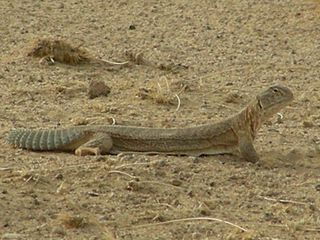
Saara hardwickii, commonly known as Hardwicke's spiny-tailed lizard or the Indian spiny-tailed lizard is a species of lizard in the family Agamidae. The species is found in patches across the Thar desert, Kutch, and surrounding arid zones in India and Pakistan. It is mainly herbivorous and lives in numbers in some areas. Since it is found in loose clusters it often attracts predators such as raptors. It is also hunted by local peoples in the belief that the fat extracted from it is an aphrodisiac.
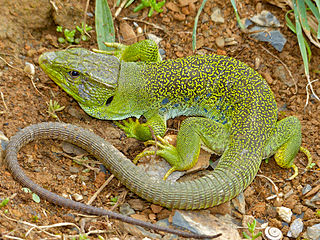
The ocellated lizard or jewelled lizard is a species of lizard in the family Lacertidae. The species is endemic to southwestern Europe.
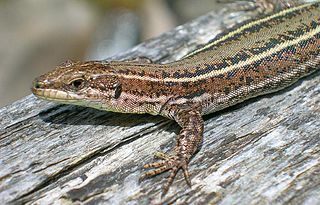
Podarcis hispanicus, also known as Iberian wall lizard, is a small wall lizard species of the genus Podarcis. It is found in the Iberian peninsula, in northwestern Africa and in coastal districts in Languedoc-Roussillon in France. In Spanish, this lizard is commonly called lagartija Ibérica.

Uromastyx geyri is a species of lizard belonging to the family Agamidae. The species is endemic to North Africa.
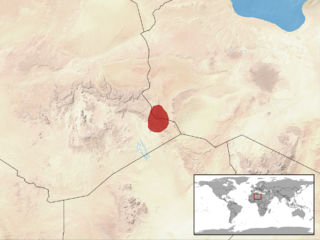
Uromastyx alfredschmidti, commonly known as the ebony mastigure, Schmidt's mastigure, or Schmidt's spiny-tailed lizard, is a species of lizard in the family Agamidae. The species is indigenous to North Africa.

Rhoptropella is a monotypic genus of lizard in the family Gekkonidae. The genus is indigenous to southern Africa.

The wildlife of Somalia includes the flora and fauna of Somalia, which is extremely diverse due to the country's location between the temperate and the tropical zones. Somalia has a long coastline, bordered by the Indian Ocean in the east and Red Sea in the north. The northwestern and central parts of the country are arid, or very dry. The southern and northeastern regions are semi-arid, receiving slightly more rainfall than the central and northwest regions. The coastal region is more humid due to its proximity to the ocean. Somalia is home to over 727 species of birds and boasts over 177 species of mammals.
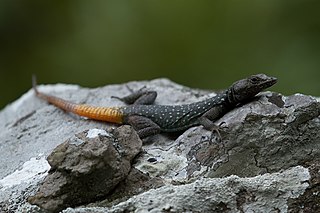
The ocellated flat lizard or Chimanimani flat lizard is a species of lizard in the family Cordylidae. It is endemic to the Chimanimani Mountains of south eastern Zimbabwe and western Mozambique.

The common torpedo, also known as ocellate torpedo or eyed electric ray, is a species of electric ray in the family Torpedinidae. It is found in the Mediterranean Sea and the eastern Atlantic Ocean from the Bay of Biscay to Angola, and is a benthic fish typically encountered over soft substrates in fairly shallow, coastal waters. Growing to 60 cm (24 in) long, this species has a nearly circular pectoral fin disc and a short, thick tail with two dorsal fins of nearly equal size and a large caudal fin. It can be identified by the prominent blue spots on its back, which usually number five but may vary from zero to nine, as well as by the small knobs on the rims of its spiracles.

Uromastyx princeps, commonly known as the princely mastigure, princely spiny-tailed lizard, or Somalian mastigure, is a species of lizard in the family Agamidae.

Uromastyx aegyptia is a species of lizard in the family Agamidae. The species is endemic to North Africa and the Middle East.

Anadia ocellata, commonly known as the ocellated anadia , is a species of lizard endemic to the Americas.
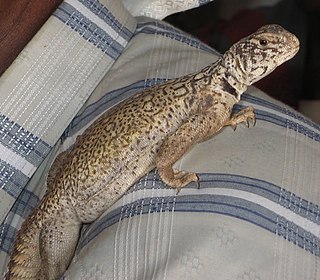
Uromastyx benti, also known commonly as Bent's mastigure and the Yemeni spiny-tailed lizard, is a species of lizard in the family Agamidae. The species is native to the southeastern Arabian Peninsula.
Uromastyx macfadyeni, Macfadyen's mastigure, is a species of agamid lizard. It is found in Somalia.
Leiolepis ocellata, the ocellated butterfly lizard, is a species of agamid lizard. It is found in Myanmar and Thailand.
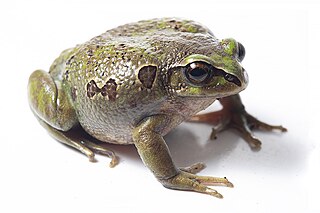
Leptopelis montanus, the ocellated burrowing treefrog, is a species of frog in the family Arthroleptidae. It is endemic to Ethiopia, and is a parapatric cryptid of the L. gramineus complex that resides in the Harenna Forest of south-eastern Ethiopia. L. montanus resides in the Bale and Arsi mountain highlands to the east of the Rift Valley.


















